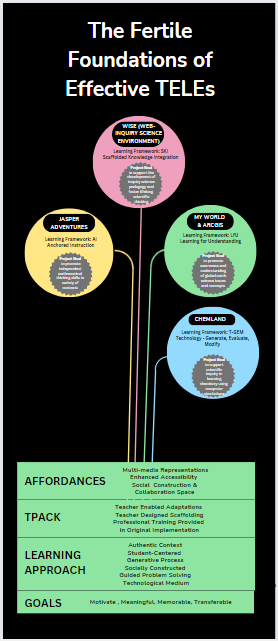TELE Blossoms in Fertile Foundations
Examining the four foundational TELEs presented in Module B reveals a lot of similarities. They all reflect a constructivist learning paradigm and employ teaching and learning strategies that encourage learners to indicate their current understandings, use new information to examine and explore how these align with their current thinking, and then expand or revise their understandings to accommodate new learnings (Khan, 2012; Edelson, 2001; Linn et al., 2002; CGTV, 1992). All the different TELEs do this in a context designed to be authentic, motivating, student-centered, and socially and technologically supported. The teacher continues to play a pivotal role, using TPACK skills. They must provide appropriately designed activities that foster conceptual and procedural knowledge for diverse learners and mediate the learning process with appropriate scaffolding, feedback, and assessment (Kim & Hannafin, 2011; Linn et al., 2002). The technological medium provides expanded affordances to learners, such as more learning autonomy, enhanced forms of representation, increased access to scaffolds from various sources (machine, peer, and teacher), and integration of technology tools to support learners to become technologically competent in a 21st-century learning environment.
The various projects covered use their specific teaching and learning frameworks, but even given these distinguishing features, I see them as more alike than different. My visual design depicting the similarities of these foundational TELEs shows the common underlying foundation that provides the rich and fertile learning components that result in the unique experiences and outcomes generated by each of the different projects and their respective frameworks.

Personally and professionally, Module B has been an interesting exercise in consolidating the importance of providing activities that reflect the elements examined. Activities should be relevant and accessible and have a socially supported component for sharing, challenging, and developing new skills and understandings. The consistent theme with technology has been its ability to provide expanded opportunities to the learning process. These insights motivate me to continue to apply and further challenge myself to integrate these teaching and learning practices and tools for learners.
References:
Cognition and Technology Group at Vanderbilt (1992). The Jasper experiment: An exploration of issues in learning and instructional design. Educational Technology, Research and Development, 40(1), 65-80.
Edelson, D. C. (2001). Learning-for-use: A framework for the design of technology-supported inquiry activities. Journal of Research in Science Teaching, 38(3), 355-385.
Khan, S. (2012). A Hidden GEM: A pedagogical approach to using technology to teach global warming. Source. The Science Teacher, 79(8), 59-62. https://www.jstor.org/stable/43557744
Kim, M. C., & Hannafin, M. J. (2011). Scaffolding problem solving in technology-enhanced learning environments (TELEs): Bridging research and theory with practice. Computers & Education, 56(2), 403-417.
Linn, M., Clark, D., & Slotta, J. (2002). Wise design for knowledge integration. Science Education, 87(4), 517-538.
